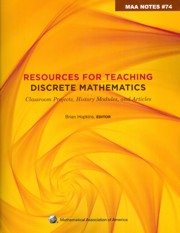Book contents
- Frontmatter
- Introduction
- Dedication
- Contents
- I Classroom-tested Projects
- II Historical Projects in Discrete Mathematics and Computer Science
- Introduction
- Binary Arithmetic: From Leibniz to von Neumann
- Arithmetic Backwards from Shannon to the Chinese Abacus
- Pascal's Treatise on the Arithmetical Triangle: Mathematical Induction, Combinations, the Binomial Theorem and Fermat's Theorem
- Early Writings on Graph Theory: Euler Circuits and The Königsberg Bridge Problem
- Counting Triangulations of a Convex Polygon
- Early Writings on Graph Theory: Hamiltonian Circuits and The Icosian Game
- Are All Infinities Created Equal?
- Early Writings on Graph Theory: Topological Connections
- A Study of Logic and Programming via Turing Machines
- Church's Thesis
- Two-Way Deterministic Finite Automata
- III Articles Extending Discrete Mathematics Content
- IV Articles on Discrete Mathematics Pedagogy
- About the Editor
Binary Arithmetic: From Leibniz to von Neumann
from II - Historical Projects in Discrete Mathematics and Computer Science
- Frontmatter
- Introduction
- Dedication
- Contents
- I Classroom-tested Projects
- II Historical Projects in Discrete Mathematics and Computer Science
- Introduction
- Binary Arithmetic: From Leibniz to von Neumann
- Arithmetic Backwards from Shannon to the Chinese Abacus
- Pascal's Treatise on the Arithmetical Triangle: Mathematical Induction, Combinations, the Binomial Theorem and Fermat's Theorem
- Early Writings on Graph Theory: Euler Circuits and The Königsberg Bridge Problem
- Counting Triangulations of a Convex Polygon
- Early Writings on Graph Theory: Hamiltonian Circuits and The Icosian Game
- Are All Infinities Created Equal?
- Early Writings on Graph Theory: Topological Connections
- A Study of Logic and Programming via Turing Machines
- Church's Thesis
- Two-Way Deterministic Finite Automata
- III Articles Extending Discrete Mathematics Content
- IV Articles on Discrete Mathematics Pedagogy
- About the Editor
Summary
The Era of Leibniz
Gottfried Wilhelm Leibniz (1646–1716) is often described as the last universalist, having contributed to virtually all fields of scholarly interest of his time, including law, history, theology, politics, engineering, geology, physics, and perhaps most importantly, philosophy, mathematics and logic [1, 9, 11]. The young Leibniz began to teach himself Latin at the age of 8, and Greek a few years later, in order to read classics not written in his native language, German. Later in life, he wrote:
Before I reached the school-class in which logic was taught, I was deep into the historians and poets, for I began to read the historians almost as soon as I was able to read at all, and I found great pleasure and ease in verse. But as soon as I began to learn logic, I was greatly excited by the division and order in it. I immediately noticed, to the extent that a boy of 13 could, that there must be a great deal in it [5, p. 516].
His study of logic and intellectual quest for order continued throughout his life and became a basic principle to his method of inquiry. At the age of 20 he published Dissertatio de arte combinatoria (Dissertation on the Art of Combinatorics) in which he sought a characteristica generalis (general characteristic) or a lingua generalis (general language) that would serve as a universal symbolic language and reduce all debate to calculation.
- Type
- Chapter
- Information
- Resources for Teaching Discrete MathematicsClassroom Projects, History Modules, and Articles, pp. 169 - 178Publisher: Mathematical Association of AmericaPrint publication year: 2009
- 1
- Cited by

